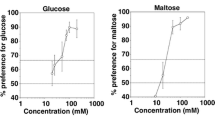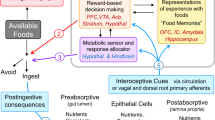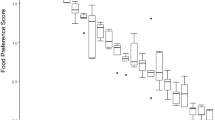Abstract
Plants possess a variety of flavor intensities and nutritional qualities that influence diet selection by herbivores. Some studies suggest that herbivores prefer less intense flavors, either in nutritious or toxic foods. However, if flavor preferences are learned, and if they are influenced by flavor-postingestive feedback interactions, then herbivores should form preferences for either weak or strong flavors when they are followed by greater nutrient rewards. We conditioned two groups of lambs with intraruminal infusions of 30 g of starch while they consumed onion-flavored straw at concentrations of 0.5% (group 1) or 4% (group 2). On alternate days, lambs received infusions of 150 g of starch while they consumed onion-flavored straw at concentrations of either 4% (group 1) or 0.5% (group 2). When offered a choice of straw in both flavor concentrations, lambs preferred the concentration—high or low—associated with the higher dose of starch during conditioning (P < 0.05). When offered a choice of onion-flavored straw in four concentrations (0.25, 1, 2, and 5%), lambs in group 1 preferred the highest onion concentration (5%), whereas lambs in group 2 preferred lower onion concentrations (0.25, 1, and 2%) (P < 0.001). the same pattern of preference was maintained when lambs had no food (day 1; no preload), or an energy(day 2; barley preload) or a protein-rich (day 3; alfalfa–soybean preload) meal before testing (P > 0.05). Lambs with no experience of onion or starch (inexperienced lambs) preferred 0.5% onion-flavored straw to 4% onion-flavored straw (P < 0.001), and 1 and 2% onion-flavored straw to 0.5% and 5% onion-flavored straw (P < 0.05). Thus, strong flavors were initially avoided (inexperienced lambs), but they came to be preferred after their association with higher doses of starch (group 1). Collectively, our results suggest that herbivores acquire and generalize preferences for flavor intensities as a function of their previous experience with the quantitative relationship between flavor intensity and nutrient reward. This ability is critical for survival because flavors, nutrients, and toxins all vary in concentrations in different plant species and parts, as well as temporally within a species.
Similar content being viewed by others
REFERENCES
Arnold, G. W., and Dudzinski, M. L. 1978. Ethology of Free-Ranging Domestic Animals. Elsevier/North Holland, New York.
Augner, M., and Bernays, E. A. 1998. Plant defence signals and Batesian mimicry. Evol. Ecol. 12:667–679.
Augner, M., Provenza, F. D., and Villalba, J. J. 1998. A rule of thumb in mammalian herbivores? Anim. Behav. 56:337–345.
Block, E. 1994. Flavorants from garlic, onion, and other Alliums and their cancer-preventive properties. In Food Phytochemicals for Cancer Prevention. Fruits and Vegetables. American Chemical Society, Washington, D.C.
Bosher, J., Auger, J., Mandon, N., and Ferary, S. 1995. Qualitative and quantitative comparison of volatile sulphides and flavour precursors in different organs of some wild and cultivated garlics. Biochem. Syst. Ecol. 23:787–791.
Eisner, T., and Grant, R. P. 1980. Toxicity, odor aversion, and “olfactory aposematism.” Science 213:476.
Kalat, J. W. 1974. Taste salience depends on novelty, not concentration, in taste-aversion learning in the rat. J. Comp. Physiol. Psychol. 86:47–50.
Launchbaugh, K. L., and Provenza, F. D. 1993. Can plants practice mimicry to avoid grazing by mammalian herbivores? Oikos 66:501–504.
Launchbaugh, K. L., and Provenza, F. D. 1994. The effect of flavor concentration and toxin dose on the formation and generalization of flavor aversions in lambs. J. Anim. Sci. 72:10–13.
Launchbaugh, K. L., Provenza, F. D., and Burritt, E. A. 1993. How herbivores track variable environments: Response to variability of phytotoxins. J. Chem. Ecol. 19:1047–1056.
Launchbaugh, K. L., Provenza, F. D., and Werkmeister, M. J. 1997. Overcoming food neophobia in domestic ruminants through addition of a familiar flavor and repeated exposure to novel foods. Appl. Anim. Behav. Sci. 54:327–334.
Lawler, I. R., Stapley, J., Foley, W. J. and Eschler, B. M. 1999. An ecological example of conditioned flavor aversion in plant-herbivore interactions: the effect of terpenes of Eucalyptus leaves on feeding by common ringtail and brushtail possums. J. Chem. Ecol. 25:401–415.
Leimar, O., and Tuomi, J. 1998. Synergistic selection and graded traits. Evol. Ecol. 12:59–71.
Nowlis, G. H. 1974. Conditioned stimulus intensity and acquired alimentary aversions in the rat. J. Comp. Physiol. Psychol. 86:1173–1184.
NRC. 1985. Nutrient Requirements of Sheep, 6th ed. National Academy Press, Washington, D.C.
Provenza, F. D. 1995a. Postingestive feedback as an elementary determinant of food preference and intake in ruminants. J. Range Manage. 48:2–17.
Provenza, F. D. 1995b. Role of learning in food preferences of ruminants: Greenhalgh and Reid revisited, pp. 233–247, in W. V. Engelhardt, S. Leonhard-Marek, G. Breves, and D. Giesecke (eds.). Ruminant Physiology: Digestion, Metabolism, Growth and Reproduction. Proceedings of the VIII International Symposium on Ruminant Physiology. Ferdinand Enke Verlag, Stuttgart, Germany.
Provenza, F. D., 1996. Acquired aversions as the basis for varied diets of ruminants foraging on rangelands. J. Anim. Sci. 74:2010–2020.
Provenza, F. D., Villalba, J. J., Cheney, C. D., and Werner, S. J. 1998. Self-organization of foraging behavior: From simplicity to complexity without goals. Nutr. Res. Rev. 11:199–222.
Provenza, F. D., Kimball, B. A., and Villalba, J. J. 2000. Roles of odor, taste, and toxicity in the food preferences of lambs: Implications for mimicry in plants. Oikos 88:424–432.
Ralphs, M. H. 1992. Conditioned food aversion: Training livestock to avoid eating poisonous plants. J. Range Manage. 45:46–51.
Ralphs, M. H., Provenza, F. D., Wiedemeier, W. D., and Bunderson, F. B. 1995. Effects of energy source and food flavor on conditioned preferences in sheep. J. Anim. Sci. 73:1651–1657.
Ramirez, I. 1997. Intragastric carbohydrate exerts both intake-stimulating and intake-suppressing effects. Behav. Neurosci. 111:612–622.
Rhoades, D. F. 1979. Evolution of plant chemical defense against herbivores, pp. 3–53, in G. A. Rosenthal, and D. H. Janzen (eds.). Herbivores: Their Interaction with Secondary Plant Metabolites. Academic Press, New York.
Rozin, P. 1969. Central or peripheral mediation of learning with long CS-US intervals in the feeding system. J. Comp. Physiol. Psychol. 67:421–429.
Spector, A. C., and Grill, H. J. 1988. Differences in the taste quality of maltose and sucrose in rats: Issues involving the generalization of conditioned taste aversions. Chem. Senses 13:95–113.
Tapper, D. N., and Halpern, B. P. 1968. Taste stimuli: A behavioral categorization. Science 161:708–710.
Van Tien, D., Lynch, J. J., Hinch, G. N., and Nolan, J. V. 1999. Grass odor and flavor overcome feed neophoia in sheep. Small Ruminant Res. 32:223–229.
Villalba, J. J., and Provenza, F. D. 1997a. Preference for wheat straw by lambs conditioned with intraruminal infusions of starch. Br. J. Nutr. 77:287–297.
Villalba, J. J., and Provenza, F. D. 1997b. Preference for flavoured foods by lambs conditioned with intraruminal administrations of nitrogen. Br. J. Nutr. 78:545–561.
Villalba, J. J., and Provenza, F. D. 1999. Nutrient-specific preferences by lambs conditioned with intraruminal infusions of starch, casein, and water. J. Anim. Sci. 77:378–387.
Villalba, J. J., and Provenza, F. D. 2000. Roles of novelty, generalization and postingestive feedback in the recognition of foods by lambs. J. Anim. Sci. In press.
Whitson, T. D., Burrill, L. C., Dewey, S. A., Cudney, D. W., Nelson, B. E., Lee, R. D., and Parker, R. 1991. Weeds of the West. Western Society of Weed Science, Laramie, Wyoming.
Author information
Authors and Affiliations
Rights and permissions
About this article
Cite this article
Villalba, J.J., Provenza, F.D. Roles of Flavor and Reward Intensities in Acquisition and Generalization of Food Preferences: Do Strong Plant Signals Always Deter Herbivory?. J Chem Ecol 26, 1911–1922 (2000). https://doi.org/10.1023/A:1005552925338
Issue Date:
DOI: https://doi.org/10.1023/A:1005552925338




